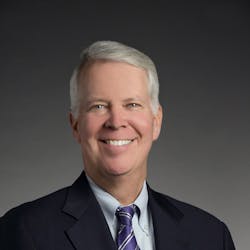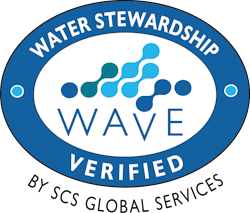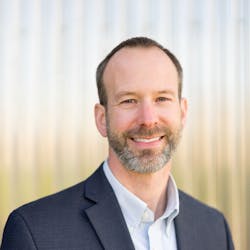Responsible water use has been a priority for Sloan, the global manufacturer of commercial plumbing systems, since its inception over a century ago. The company’s first product, the Royal Flushometer, cut water use in toilets in half when it was released in 1906.
“Water stewardship is what the company has been built on,” said Patrick Boyle, Sloan director of corporate sustainability. “Producing high-quality products here in America that are water efficient is part of our DNA, and we’re proud to be stewards of Earth’s most precious resource.”
“We really mean what we say,” Boyle said. “We talk the talk and walk the walk.”
What is WAVE?
The Water Council, a Milwaukee-based nonprofit dedicated to freshwater innovation and water stewardship, introduced WAVE (Water Stewardship Verified) in February. The program helps companies understand their water uses and impacts, assess risk, and lay the foundation to develop thoughtful strategies, set meaningful goals and take impactful action on water across the enterprise.
Importantly, to counter possible “greenwashing” claims, participants are independently verified by SCS Global Services, a global leader in third-party verification of sustainability claims. After completing the process, participants can use the WAVE seal in their branding and reporting to key stakeholders.
Growing Emphasis on ESG Goals
Corporate water stewardship is increasingly important as climate change exacerbates problems such as droughts, floods, deteriorating infrastructure and poor water quality. Investors are picking up on the issue with the growing focus on environmental, social and governance (ESG) reporting metrics. A recent Ceres report found industry is driving critical risks to global freshwater systems, the international economy and investment portfolios.
The water technology industry knows better than most the water-related risks faced by companies. After all, many of these companies offer solutions to measure water use, increase water efficiency, treat contaminated water, reduce stormwater runoff or handle flooding.
Why WAVE Wave Was Created
The Water Council was founded in 2009 to harness the economic development potential of the industry and counts many leading water technology companies among its members. In 2014, it expanded its mission to include water stewardship as the North American Regional Partner of the Alliance for Water Stewardship, a role it held until 2021.
Through its stewardship work, The Water Council saw a critical gap in the market for companies looking to start or accelerate their water stewardship performance and enact holistic water stewardship policies and practices across their entire enterprise. It created WAVE to help companies better understand and implement good corporate water stewardship practices as well as publicly recognize those efforts through independent verification. The six-step process is built on international best practices of assessing and addressing water-related risk across the enterprise.
“The Water Council’s ongoing work on water stewardship is a natural extension of our water innovation platform,” said Dean Amhaus, president and CEO. “As companies that require water in their operations come to grips with their water challenges, they will adopt new management practices and come to realize the advantages of incorporating new technologies. The Water Council is able to connect them to those innovations."
As The Water Council developed the WAVE in 2021, founding members A. O. Smith Corporation and Badger Meter and new member Watts Water Technologies volunteered to pilot it. Rounding out the pilot companies is Nutrien, an agribusiness company outside the water tech sector.
“I am especially proud that some of our members took the initiative to be first adopters as they understood the financial and brand value back to their companies,” Amhaus said.
Benefits of the WAVE Program
Watts, based in North Andover, Mass., joined The Water Council in 2021 and quickly saw the benefit of participating in the WAVE pilot program to support the company’s growing role in global water stewardship and sustainability.
Through WAVE, Watts examined the water risk at each of its 42 major sites and choose eight sites that were either large consumers of water or in regions of relatively high water risk. It evaluated the watersheds where the sites are located and started connecting with shared watershed users such as municipalities, water and wastewater treatment utilities, community organizations and third-party services.
“It’s an evolution from looking at water use just within the four walls to looking at it with a community- and context-based perspective,” said Samantha Akella, manager of global sustainability programs.
How Companies Are Using WAVE
As a result of the program, Watts took a variety of actions at the local and global level to reduce water consumption, increase reuse, improve water quality, and reduce negative impacts upstream and downstream. These included expanded water metering, continued community engagement and site-specific projects.
Watts has updated its Corporate Environment, Health, Safety and Sustainability Policy to reflect its goal to advance local and global water stewardship across its facilities and in the communities where it operates. It published a water stewardship report on its website in January.
Milwaukee-based A. O. Smith Corporation has also been increasing its water stewardship efforts in recent years, Stern said. For example, it recycles most of the water used in testing cycles at its corporate technology center that opened in 2018.
Joining the WAVE was the logical next step for the company, Stern said.
“As a water technology company and a good citizen, we feel that water stewardship is an absolute necessity for our company,” he said.
One of the most valuable parts of the process for A. O. Smith has been crafting a corporate water stewardship policy, along with looking at best practices across the industry, Stern said. The company is nearing completion of the WAVE program and hopes to start the verification process this summer. It also recently hired its first ESG director.
The Value of Independent Verification
Independent verification is crucial as investors and consumers look more critically at sustainability and ESG claims, said Rae Mindock, program manager for responsible water practices at SCS Global Services.
“There can be a component of greenwashing in ESG work,” Mindock said. “Our interest in WAVE is that component is gone.”
SCS Global Services’ verification team is independent and goes into the process blind, she said. The team requires evidence to verify each required item.
Water technology companies gain a particular benefit by independently verifying their water stewardship efforts, said Matt Howard, vice president of water stewardship at The Water Council.
“They’re leading by example,” he said. “When they’re talking with clients and customers about water challenges, they can point back to their own operations and their world-class water stewardship performance. It’s a win-win for the environment and the industry.”
About the Author
Stacy Vogel Davis
Communications Director
Stacy Vogel Davis is communications director for The Water Council. She can be reached at [email protected].




